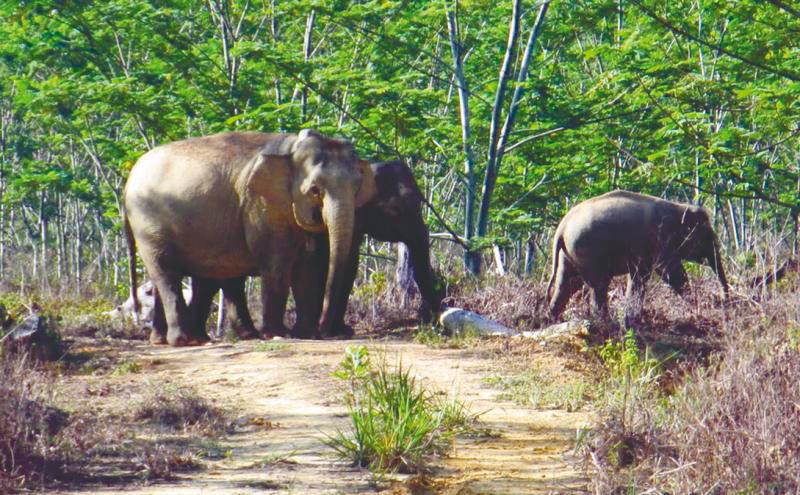IT started out like any ordinary day. Having completed his work at a nearby forest reserve, 38-year-old research assistant Frederick Kusam was making his way home. His work as an elephant conservation research assistant for the Sabah Landscapes Programme at World Wide Fund for Nature-Malaysia (WWF-Malaysia) means that he spends long hours in forest reserves, and equally long hours to and from his forest workplaces.
This day was no different. Frederick was two hours in on his journey on the Maliau-Kalabakan road when he stopped by the side of the road for a much needed rest.
As he stretched his legs outside his car, something large caught his eye. Not far from where he was standing, an elephant, magnificent in size, came out of an adjacent forest and crossed the road, only to disappear into the forest again. But before Frederick could breathe a sigh of relief, the elephant returned and to his horror, began making its way towards the car.
The scenario Frederick was facing is not an uncommon one in parts of Sabah. Bornean elephants inhabit the forests of Sabah, with a small population in northern Kalimantan. They are the smallest subspecies of elephants in the world. However, as the smallest elephants, they are still large in stature - standing between an average of seven and eight feet tall.
Bornean elephants continuously face numerous threats to their existence, arising from human-elephant conflict and poachers, whose snares intended for smaller animals trap the elephants instead.
Elephants are also threatened by the loss of habitat they utilise – typically referred to as elephant ranges – that are converted into agriculture plantations, settlements and roads.
Elephants are a social species, and are known to travel in groups called herds. They move in search of food and shelter. The routes they take are through knowledge and experience passed down from generation to generation. Even when those routes are converted into our roads, elephants will still journey through.
For road users in parts of Sabah, the sight of elephants crossing is not new. Elephants are known to forage along roads where grass grows abundantly. Like Frederick, many who frequent the Sapulut-Maliau-Kalabakan road would have had a chance to encounter elephants. It is on such roads that humans and elephants intersect.
For us humans, roads give us access to our homes, to work, and thus, contribute to our livelihoods. But more than this, roads also provide access to healthcare facilities. It is crucial for the transport of commodities, and thus, contribute to economic growth and trade. For the elephants, the same road is a remembered path that gives them access to food and larger foraging grounds.
As such, humans should ensure these encounters do not end in conflict. When Frederick saw the elephant heading towards him, he did not panic. Instead, he moved back slowly. The elephant eventually stopped and made its way into the forest.
Frederick’s actions are in contrast with the actions of several individuals who filmed an elephant encounter recently. In a video that went viral on social media, the individuals were seen approaching a group of elephants with young ones crossing the same stretch of road, trying to get the elephants to move away. Alarmingly, the individuals were also seen to be trying to capture close-up photos and videos of the elephants.
Startled, and perhaps sensing danger in the situation, maternal instincts kicked in and the adult female elephants started to mock charge towards the individuals.
Although the elephants stopped charging and the individuals made it to the safety of their cars, the situation could have gone horribly wrong. The encounter could have ended in tragedy, and another statistic of human-elephant conflict would have been recorded.
The narrative today should no longer be a “us vs them” scenario. Humans and elephants can coexist, and in incidences where humans and elephants encounter each other, we should take precautions to protect both ourselves and the elephants.
Under the Sabah Landscapes Programme (SLP), elephant conservation efforts are underway to safeguard the Bornean elephant population and promote human-elephant coexistence. SLP, through its three pillars – Protect, Produce and Restore – conducts elephant satellite collaring to identify the Bornean elephant’s key space requirements, which in turn will be used to reduce future conflicts.
Additionally, SLP works to restore ecological corridors to connect fragmented habitats to facilitate the movement of wildlife, like the elephant. These corridors are also crucial to increase gene flow to reduce the negative effects of inbreeding as well as to provide connectivity to areas of higher elevation in the event of climate change.
Together with the state government, private corporations and other NGO in Sabah, SLP will continue to play their role in the conservation of Bornean elephants.
There are less than 1,500 Bornean elephants left in the wild. As the state government, NGO and corporations do their part to continue securing the future of the Bornean elephants, so too should individuals play their role.
Individuals encountering elephants in the wild have both a privilege and a responsibility – a privilege to come across the largest land mammal in its natural habitat, and a responsibility to allow these majestic creatures a safe space to inhabit.
Let us to do something to safeguard our iconic species, and be empowered to take action to protect our largest land mammals.
Here are several ways we can do that:
Ethical tips when encountering elephants
1. Stop your vehicle and give way to passing elephants.
2. Do not attempt to get down from the vehicle to take close-up photos.
3. Maintain a safe distance of at least 50m between yourself and the elephants at all times.
4. Do not panic when encountering elephants. Keep calm and wait until they have passed.
5. Do not feed the elephants. They will come to associate people with food and may approach vehicles more frequently in the future.
6. Do not honk at the elephants. Loud sounds may startle or agitate them.
7. Dim your car lights if you happen to encounter the elephants on the road at night.
The article is contributed by the WWF-Malaysia. Comments: letters@thesundaily.com










